continuousWave --> Whaler --> Cetacea
Previous | Next
![[Logo: WHALER CETACEA]](graphics/cetaceaLogo230x60Trans.gif)
Cetacea Page 50
January 26, 2002
Fabulous Fifteens
15 X 15 = 4 Classic Whalers
After many installments showing larger boats, CETACEA returns to the
real roots of Boston Whaler boating, the smaller open boats like the Classic 15-foot Boston Whaler.
Positioned between the 13-foot and 17-foot classics, the 15-foot
hull provides the owner with the simple fun of the original Whaler but
a much gentler ride resulting from a new underwater hull shape.
The 15-foot hull appeared in 1976, approximately the fifth hull developed by
the fine designers of Rockland, Massachusetts, following the
original 13-foot (1958), the 16-foot (1961), the 21-foot (c.1970),
and the 19-foot (c.1970).
The 15-foot design added a very fine bow entry and the now famous "smirk" to the
forward half of the boat, and refined the stern into a broadly
rounded central vee with smaller sponsons. This same general stern
shape would appear in the 1977 redesign of the 16/17-foot hull.
The result was a boat that gave a much gentler ride, but gave up a bit
of the amazing lateral stability of the twin-sponson approach.
The gunwales were kept low, like the 13-foot, and the boat was intended
to be piloted while sitting.
Seating, in fact, was to be the weak point of the 15-foot hull.
Most every one I've seen seems to have had some owner added modifications
trying to improve on the original plain, backless thwart seats.
Here are fifteen pictures of 15-foot Whalers of four different models
and how their owners improved them.
January Cruising in Vancouver
Whaler owner Andrew Sherlock of Vancouver, British Columbia, sent
a batch of very nice digital images and notes on his 1989 Boston Whaler 15-GLS
from the Pacific Northwest. Andrew (aka Toad2001) writes:
"Here are some photographs for CETACEA of my
1989 15-GLS with 40-HP Mariner (4 cylinder 2-stroke).
The boat is all original except the sunbrella console cover
and the padded seats installed on aft thwart.
We just bought our Whaler as a tender to tow behind our diesel trawler.
She's a saltwater boat, and will be used mostly in the Strait of Georgia
between Vancouver Island and mainland British Columbia.
I took these on Sunday, January 7, 2001. It was cool, but clear.
Future upgrades will include fish/depth finder, full mooring cover, anti-fouling.
"I just found your site. It's really informative."
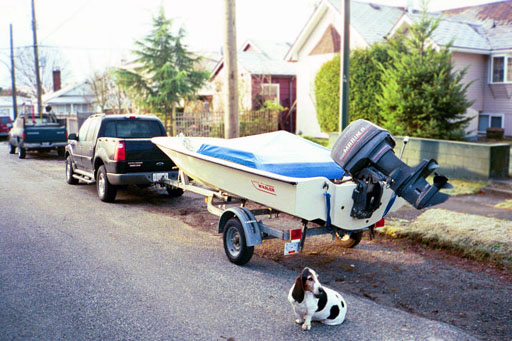 |
15 GLS
First introduced in 1976, the 15-foot hull combines the low freeboard of the orginal Boston Whaler with a new hull shape. The sponsons decreased in size and the central hull took on a deeper, rounded vee. Nautical companion Lowla awaits departure in the foreground.
PhotoCredit: Andrew Sherlock - Reference: 50-01 |
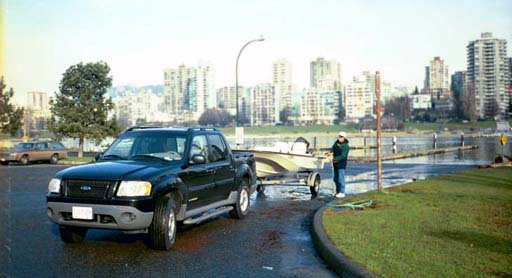 |
Easy Lauch
Among its many attributes, the 15-foot hull is very easily launched or recovered by trailer. It can be truly a one-man/one-dog job. This nice ramp facility at False Creek, Vancouver, British Columbia, provides a fresh water washdown.
PhotoCredit: Andrew Sherlock - Reference: 50-02 |
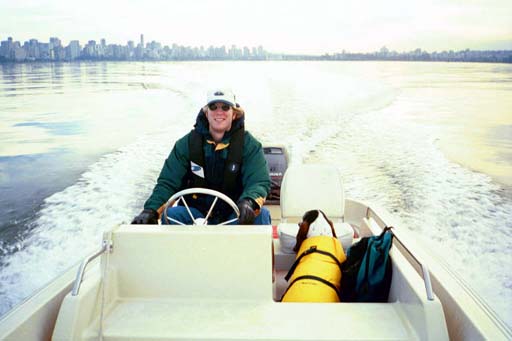 |
January Run
Out for a rather cool afternoon cruise on January 7th, the Boston Whaler has the harbour all to itself. The GLS model was formed by the addition of the molded seat/console insert and a molded thwart seat. The Sherlocks added the cushion seats and seatbacks. Lowla keeps watch astern while Andrew has the helm. Air temperature is just above freezing.
PhotoCredit: Andrew Sherlock - Reference: 50-03 |
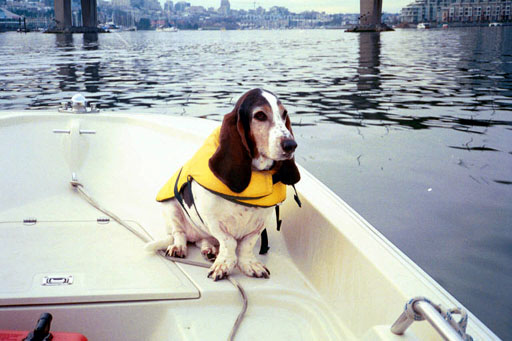 |
Bow, Bow-Wow
Lowla demonstrates a feature of the 15-foot hull: it has a large, flat area in the bow that makes a good spot to stand or sit. By 1989 the hatch cover had evolved to a molded lid with hinges. The orignal design was wood and just set in place. You often see home made replacements for those (as they seem to be easily lost).
PhotoCredit: Andrew Sherlock - Reference: 50-04 |
Summer Cruising
Andrew also gets out in the summer, as these nice photographs show.
The waters of the Pacific Northwest look quite inviting.
Boating companions include Lowla, the 5-year-old Basset Hound, and wife Donna
(unseen but behind the camera in most of these shots).
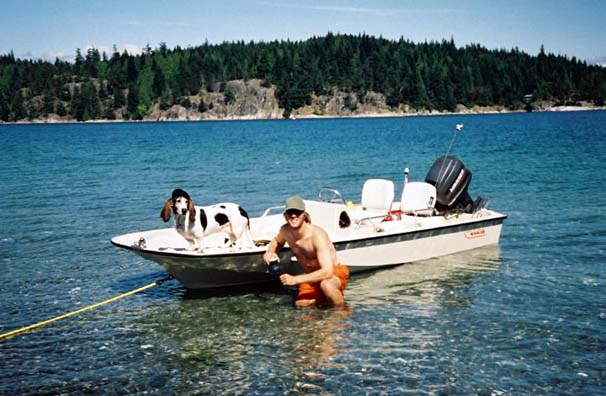 |
Shoreside at Shark Spit
Like the smaller Whalers, the 15-foot hull has low freeboard and shallow draft, two features which make it a natural for beaching the boat. The finer bow entry makes the boat more sensitive to weight in the bow. Even just Lowla getting up there can affect the trim. This is "Shark Spit", a sand/oyster shell jetty which due to tidal effect resembles the shape of a shark's fin. Andrew says, "Note the stern anchor, and bow line tied to a beached log, allowing me to anchor out to avoid getting caught in a falling tide."
PhotoCredit: Andrew Sherlock - Reference: 50-05 |
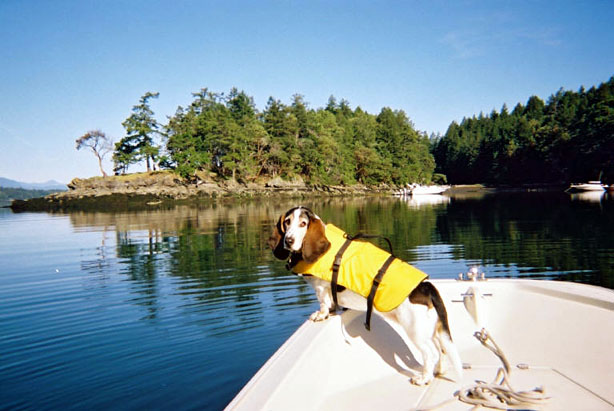 |
Shore Patrol
Lowla sends a clear signal that she'd like to visit this island at Wallace Island Marine Park, in the Gulf Islands, British Columbia.
PhotoCredit: Andrew Sherlock - Reference: 50-06 |
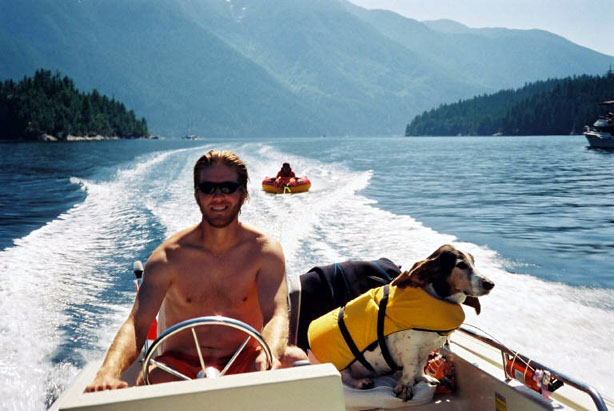 |
Pendrell Sound
Lowla and the 15-GLS enjoy horsing around in Pendrell Sound, near Desolation Sound, British Columbia. Pendrell Sound is reported to have the warmest water north of Mexico on the west coast of North America. Ocean waters here in July-August can get over 80-degrees.
PhotoCredit: Andrew Sherlock - Reference: 50-07 |
Sandy's Whaler
Sandy Mackenzie has a customized 15-footer that he recently re-powered.
Here is the background:
"Jim, here's my boat:
"This 15-footer was sold new in 1980 as a bare hull to the previous owners,
who outfitted her with a swivel pilot seat, fiberglass console
and plexi-windscreen.
There was a tall bow rail (like Clark Roberts') and the front thwart
and hatch were mahogany.
Our family acquired her in 1985, and she was enjoyed in the above
configuration for about ten years before she started to morph into
a 'Sport-Super Sport!'.
My father put in a rear thwart with a hatch (similar to the Super Sport)
to cover up the new fiberglass tank, battery,life jackets, etc.
We removed the bow rail, because we wanted forward boarding access.
"I took ownership in 1999, traded in the old 70 Evinrude on a new 90 Merc,
and installed hydraulic steering. This past summer, I built a mahogany console
to match the rear setup, replaced the front thwart and built a hatch for the bow.
The jack plate was the last thing to go on, along with a few other interior
touches (like stainless throttle mount, washer plate for transom, etc.).
"I took this shot after a hot, windless August day at my friend's cottage
in the Thousand Islands (St. Lawrence River). It marked the end of another
perfect summer with ol' Flipper. Thanks, Sandy"
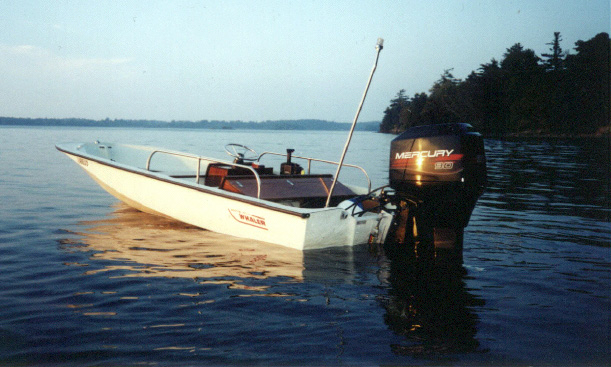 |
Flipper
The 15-foot hull handles the extra weight of a jack plate and a big, modern outboard without too much trouble. With this much power, the boat must be a rocket.
PhotoCredit: Sandy Mackenzie - Reference: 50-08 |
Custom Console
Although Whaler eventually did produce a 15-footer with a center console,
it came rather late in the development of the boat. Gene Morrison, who from
the evidence seen here appears to be a darn good boatwright, crafted his
own center console solution for the Whaler 15-footer. Gene writes:
"James, here's some info on my 1988 15-Whaler:
"The original hull was set up as a STRIPER with a fiberglass console
and mahogany seats.
"I designed the console to reuse the plexiglass windshield but have not
installed it. The console is walnut with holly in-lay strips, and the sideboards
(with notches to adjust mahogany seat) are walnut also.
The foward locker hatch was modified to ease anchor removal. I've updated
it since the photos, with a stainless steel piano hinge down each side.
The mahogany seats are the only original wood remaining in use.
Unfinished plywood (flush with the forward deck) makes fishing less hazardous
in rough water. I've got two pieces of plywood cut [for that location],
one has a cut-out for a 48-quart cooler in front of the console."
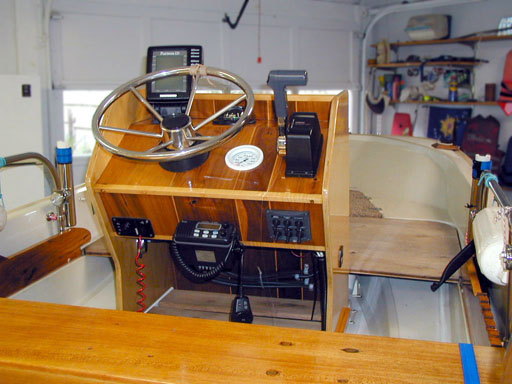 |
Custom Console
This well proportioned and nicely built custom wooden center console is located more forward than the original helm. New seat risers appear to be notched, which may allow the seat position to be moved fore and aft as desired. They also raise the height of the seat several inches above its original level.
PhotoCredit: Gene Morrison - Reference: 50-09 |
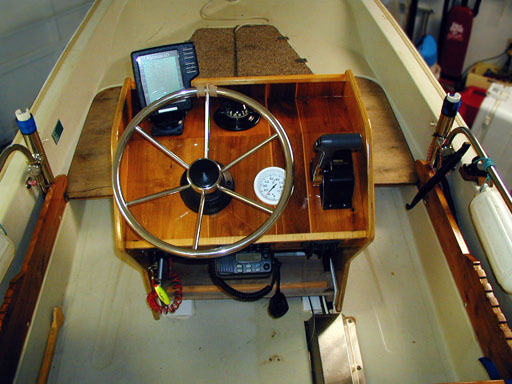 |
Helmsman's view
The bow locker hatch has been replaced with a dual opening hatch. The bow area is leveled out with a plywood platform shaped to rest on the molded lip of the hull.
PhotoCredit: Gene Morrison - Reference: 50-10 |
Georgia Striper
Savannah (Georgia) fisherman David Roach made a timely contribution (about two days ago!)
of pictures of his 15-foot Boston Whaler, a somewhat uncommon STRIPER model.
This boat looks to be in wonderful condition. David writes:
"I recently discovered your Classic Whaler site and was happily surprised to
find that I am not the only Whaler fanatic out there! I thought you all
might enjoy seeing a 15-Striper as I couldn't find one anywhere on the site.
"I'm the original owner; purchased new in 1989. She carries hull number SB3448.
[Perhaps 5B3448, as this seems to fit the numbering scheme, 5= fifteen, B= second mold
in this series, and 3448 = consecutive serial number of boats from the mold?]
Power is a 60-horsepower Evinrude. I wanted the 60 because it's a 3-cylinder
engine and does very well on fuel. As you can see from the photos, almost
everything on the boat is original. Somewhere around the time that I turned
forty, I moved the Igloo cooler seat from behind the console over to the port
side and moved the chair that was mounted there back over behind the console
so that I could have a little support for my back while underway. There's
another chair that mounts up front--more on that later. This is an
excellent inshore fishing boat for my area, coastal Georgia. Whaler
advertised her in 1989 as follows:
The ruggedly built Striper is designed for the fisherman who wants to divide
his time between prowling the inland rivers and lakes and trying his luck in
coastal waters. It likes quiet places, where the only congregation you'll
find is of fish. Inland fishermen swear by the optional forward and aft
pedestal seats that give the Striper its deadly bass fishing efficiency. But
no matter where they cast their lines, all fishermen will value the Striper's
stable, unsinkable hull.
"Interestingly, I hadn't read that excerpt from Whaler's literature since I
bought the boat 12 years ago. It's uncanny how accurately they pegged my use
of the boat for all of these years. When fishing inshore, I fish for spotted
sea-trout and redfish (bass) up and down the Georgia coast. Most of our
"fishing drops" are rather secluded places where salt water mingles with the
fresh water rivers along Georgia's network of barrier islands, marshes, and
sounds. This little boat is absolutely perfect for our type of fishing. It
easily handles the crossing the "big waters" of our major sounds, yet allows
me to sneak way up into the tidal creeks and flats that border our barrier
islands."
"I normally keep the front pedestal seat in the garage as I prefer to stand
when I fish. Also, there are certain times of the year when I lash a beach
cart onto the front of the boat and run around on the front side of our
barrier islands to surf-fish for huge red drum (redfish, bass, whatever you
prefer to call them). For that trip, the Whaler has to negotiate crossing
the sound, then make a three or four mile run along the beach (meaning in the
ocean) and then, and here's the trick, run up into a tidal "cut" right on the
beach that leads to protected water back behind the sand dunes. From there,
we load the cart with our gear and roll it back to the surf. Try THAT with a
larger boat. Or, try making the run through the ocean in some other small
boat. Either way, I'm always glad I'm in the Striper."
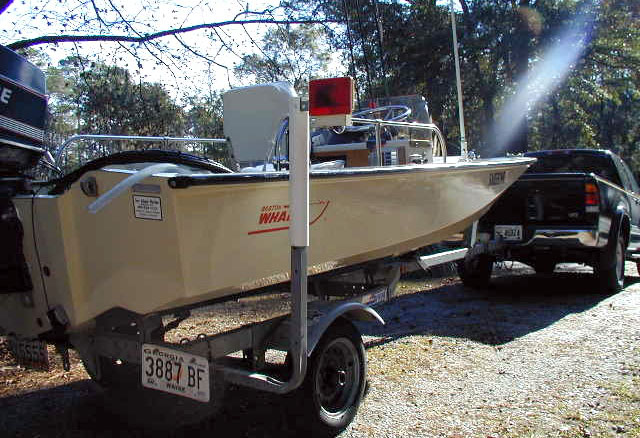 |
15 Striper
The distinctive hull form of the 15-foot Whaler shows itself again here. An interesting lens flare appears to lend heavenly approval of the boat.
PhotoCredit: David Roach - Reference: 50-11 |
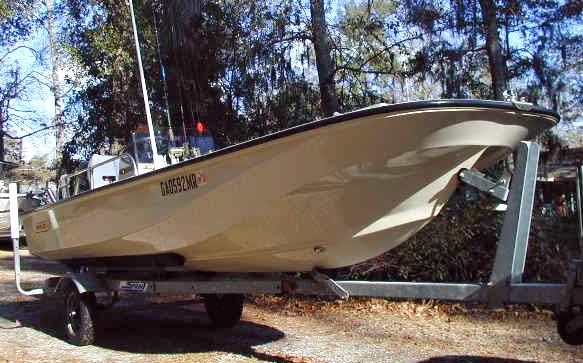 |
15 Striper
The front of the 15-hull features this complex shape, which provides a sharp central vee-hull for entering waves and several strakes and chines to deflect water down and away from the hull. The Desert Tan gelcoat looks like it is in factory-fresh condition. Like most trailerable boats, no bottom paint obscures these fine lines.
PhotoCredit: David Roach - Reference: 50-12 |
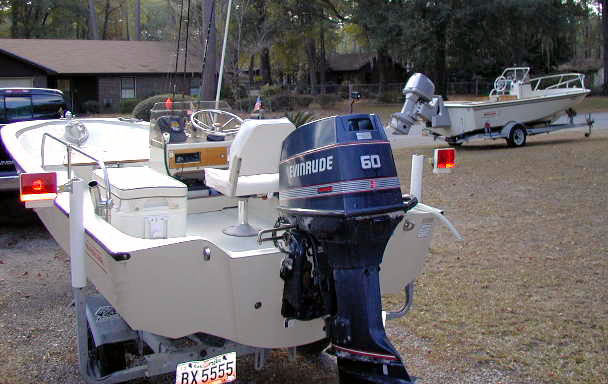 |
15 Striper
The original layout of swivel chair on Port and cooler seat on starboard have been reversed. This boat looks like new! The camera has turned the tan gelcoat to white in this view. By the way, the boat in the background looks like an 18-Outrage with a full transom and SeaDrive.
PhotoCredit: David Roach - Reference: 50-13 |
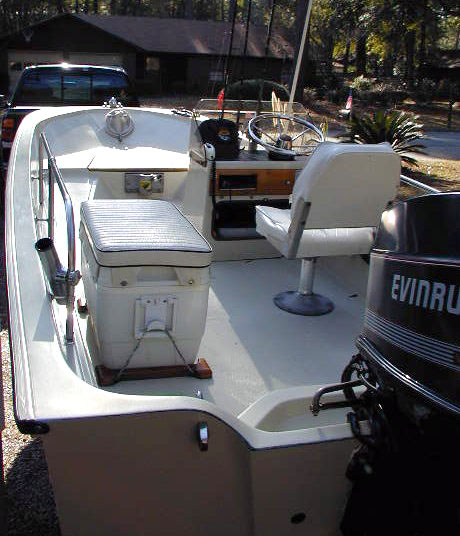 |
15 Striper Cockpit
"With the former console seat/cooler moved to the port side and turned lengthwise, there is now an unrestricted 'lane' from the stern all the way to the bow. That's a plus on a boat this small."
PhotoCredit: David Roach - Reference: 50-14 |
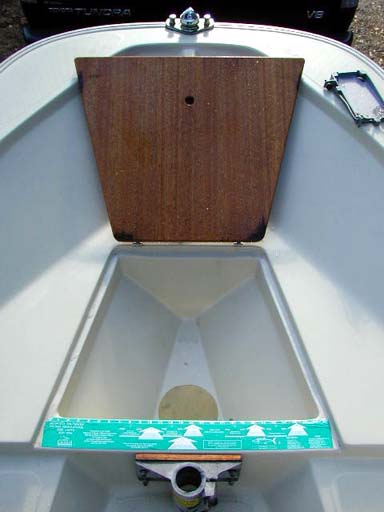 |
Whaler 15 Bow Locker and Sprue Hole
"Here's a detail of the forward locker. The bracket at the bottom holds the forward pedestal seat, when it is installed. I use the forward locker for fish. Note the measuring tape sticker on the lip of the locker. It's a simple matter to measure a fish, and drop him right on in the locker/cooler if he's a keeper." [Also note the sprue hole through which the interior foam was introduced--jimh.]
PhotoCredit: David Roach - Reference: 50-15 |
More Reading
For more information on the Whaler 15-foot hull see the
REFERENCE
section of the website. Several long road trips taken with a 15-foot Boston Whaler in tow are narrated in the Sail-Logs section of the website. Look for the "Trailer Boat Tales" features.
continuousWave --> Whaler --> Cetacea
Previous | Next
DISCLAIMER: This information is believed to be accurate but there is no
guarantee. We do our best!
The page has been accessed 84351 times.
Copyright © 2002 by James W. Hebert. Unauthorized reproduction prohibited!
This is a verified HTML 4.0 document served to you from continuousWave
URI: http://continuouswave.com/whaler/cetacea/cetaceaPage50.html
This article first appeared January 26, 2002.
Last modified: Sunday, 01-Jun-2003 14:56:38 EDT
Author: James W. Hebert

![[Logo: WHALER CETACEA]](graphics/cetaceaLogo230x60Trans.gif)













